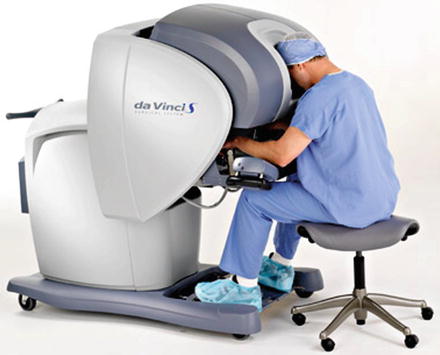Investigators
Evidence type
Procedure
Number of patients
Access
Operation time (in minutes)
Ostrowitz et al. [1]
Prospective clinical series
Right hemicolectomy
3
SILS port
166
Romanelli et al. [2]
Case report
Cholecystectomy
1
Separate fascial incisions
156
Ragupathi et al. [3]
Clinical case report
Partial cecetomy
1
GelPort
120
Singh et al. [8]
Clinical case report
Right hemicolectomy
1
GelPort
179
Kroh et al. [5]
Prospective clinical series
Cholecystectomy
13
Glove technique
107
Wren and Curet [4]
Comparative studya
Cholecystectomy
10
da Vinci SSI
105.3
Morel et al. [6]
Prospective clinical series
Cholecystectomy
28
da Vinci SSI
80
Spinoglio et al. [9]
Comparative studyb
Cholecystectomy
25
da Vinci SSI
62 [13]
Konstantinidis et al. [11]
Case series
Cholecystectomy
45
da Vinci SSI
84.5
Pietrabissa et al. [12]
Multicenter prospective case series
Cholecystectomy
100
da Vinci SSI
71
12.2.2 Outcomes
Outcomes gleaned from the literature seem to establish the safety of single-incision robotic surgery. Pietrabissa et al. reported a conversion rate of 2 % in a series of 100 cholecystectomies, with one conversion to multiport laparoscopy and the other to open surgery, both due to severe chronic inflammation. Minor complications encountered included gall bladder rupture (7 %) and bleeding (5 %). Konstantinidis et al. in a study of 45 patients who underwent cholecystectomy reported no conversion to open surgery, although additional port placement was required in three patients. Complication rates were similarto the study by Pietrabissa et al. and 40 of the patients were discharged within 24 h. Interestingly, the duration of surgery did not change significantly with increasing operative experience. The remaining studies were too small to draw meaningful conclusions regarding outcomes, but the feasibility of such procedures has been established.
12.2.3 Contraindications
Contraindications for single-incision robotic surgery are not dissimilar to those for conventional laparoscopic surgery or multiport robotic surgery. Robotic general surgery (abdominal procedures) are usually performed in the Trendelenburg or reverse Trendelenburg position; thus, the physiologic effects of a steep incline and pneumoperitoneum creation must be taken into account. The most important physiologic changes are listed in Table 12.2.
Table 12.2
Physiologic changes associated with the Trendeleburg position
Physiologic variable | Position-induced change |
|---|---|
Intracranial/intraocular pressure | Increase |
Central venous pressure | Increase |
Cardiac output | Decrease |
Blood pressure | Increase |
Venous return | Increase then decrease |
Systemic vascular resistance | Decrease |
Airway resistance | Increase |
Due to the potential for risky physiologic changes, the following are considered relative contraindications for robotic surgery:
History of cerebrovascular accident, intracranial aneurysm, elevated intracranial pressure, or glaucoma
Severe chronic obstructive pulmonary disease, bullous emphysema, spontaneous pneumothorax, or diaphragmatic hernia
12.3 Description of the Technique
12.3.1 Basic Structure
The typical robot consists of the surgical console, a three-dimensional camera system, and a bedside cart equipped with robotic arms. Conventional robotic surgery uses four separate arms; one for the camera and the other three for the instruments. Slight variations exist between different generations of systems, but the principles remain the same. The locations of the ports vary according to the type of procedure being performed.
Single-port/single-site robotic surgery is a modification of the multiport approach and can be carried out in two ways. One method involves inserting three ports of the multiport robotic system through separate but closely placed incisions or through a GelPort® device (Applied Medical, Rancho Santa Margarita, USA) or simply through the fingers of a standard surgical glove. A newer method takes advantage of a specially designed single-incision platform comprising a large silicone port with four channels and commonly placed in the umbilicus. The single-port robotic trocars and instruments differ in design from those of the conventional robotic system.
12.3.2 Individual Components
12.3.2.1 Console
The da Vinci console developed by Intuitive Surgical is currently the only commercially available robot. A number of robot alternatives are in various stages of development and are projected to enter the market within the next few years. The console shown in Fig. 12.1 may be housed at a remote location, but at most hospitals, the console is housed within the operating room itself.










